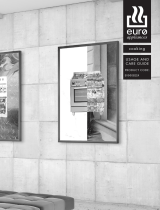
Contents
1. INSTRUCTIONS FOR USE ................................................................................................... 30
2. SAFETY PRECAUTIONS ...................................................................................................... 32
3. ENVIRONMENTAL CARE ..................................................................................................... 34
3.1 Our environmental care ................................................................................................................................ 34
3.2 Your environmental care ............................................................................................................................... 34
4. GET TO KNOW YOUR APPLIANCE ..................................................................................... 35
4.1 Description of the controls on the front panel ............................................................................................... 35
5. AVAILABLE ACCESSORIES ................................................................................................. 36
5.1 Using the rack ............................................................................................................................................... 37
5.2 Using the tray ................................................................................................................................................ 37
5.3 Using the rotisserie rod (on some models only) ............................................................................................ 37
6. USING THE COOKING HOB ................................................................................................. 38
6.1 Layout of the cooking zones ......................................................................................................................... 38
6.2 Cookware suitable for use in induction cooking ............................................................................................ 39
6.3 Limiting the cooking duration ........................................................................................................................ 39
6.4 Protection from hob overheating ................................................................................................................... 39
6.5 Advice on energy-saving ............................................................................................................................... 39
6.6 Power levels .................................................................................................................................................. 40
6.7 Cookware recognition ................................................................................................................................... 40
6.8 Residual heat ................................................................................................................................................ 40
6.9 Heating accelerator ....................................................................................................................................... 40
6.10 Booster function .......................................................................................................................................... 41
6.11 Power management .................................................................................................................................... 41
6.12 Control lock ................................................................................................................................................. 41
7. USING THE OVEN ................................................................................................................ 42
7.1 Before using the appliance ........................................................................................................................... 42
7.2 Oven runners ................................................................................................................................................ 42
7.3 Storage compartment (on some models only) .............................................................................................. 42
7.4 Cooling system ............................................................................................................................................. 42
7.5 Internal light .................................................................................................................................................. 42
7.6 General warnings and advice for use ........................................................................................................... 43
7.7 Electronic programmer (on some models only) ............................................................................................ 44
8. COOKING WITH THE OVEN ................................................................................................ 46
8.1 Cooking advice and instructions ................................................................................................................... 47
9. CLEANING AND MAINTENANCE ......................................................................................... 48
9.1 Cleaning stainless steel ................................................................................................................................ 48
9.2 Ordinary daily cleaning ................................................................................................................................. 48
9.3 Food stains or residues ................................................................................................................................. 48
9.4 Cleaning the glass ceramic hob .................................................................................................................... 49
9.5 Weekly cleaning ............................................................................................................................................ 49
9.6 Cleaning the oven ......................................................................................................................................... 50
10. EXTRAORDINARY MAINTENANCE .................................................................................. 51
10.1 Removing the door ...................................................................................................................................... 51
10.2 Replacing the light bulb (main oven) ........................................................................................................... 51
11. INSTALLATION .................................................................................................................. 52
11.1 Installing in kitchen units ............................................................................................................................. 52
11.2 Electrical connection ................................................................................................................................... 53
11.3 Positioning the skirt (on some models only) ................................................................................................ 54
11.4 Positioning and levelling the appliance ....................................................................................................... 54
INSTRUCTIONS FOR THE USER: these contain user advice, the description of the controls and
the correct procedures for cleaning and maintenance of the appliance.
INSTRUCTIONS FOR THE INSTALLER: these are intended for the qualified technician who must
install the appliance, set it functioning and carry out an inspection test.
Further information about the products can be found at www.smeg.com
29






















